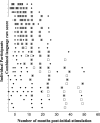The effect of age at cochlear implant initial stimulation on expressive language growth in infants and toddlers
- PMID: 16378478
- PMCID: PMC3209960
- DOI: 10.1044/1092-4388(2005/059)
The effect of age at cochlear implant initial stimulation on expressive language growth in infants and toddlers
Erratum in
- J Speech Lang Hear Res. 2005 Oct;48(5):1243
Abstract
This study examined the growth of expressive language skills in children who received cochlear implants (CIs) in infancy. Repeated language measures were gathered from 29 children who received CIs between 10 and 40 months of age. Both cross-sectional and growth curve analyses were used to assess the relationship between expressive language outcomes and CI experience. A beneficial effect of earlier implantation on expressive language growth was found. Growth curve analysis showed that growth was more rapid in children implanted as infants than those implanted as toddlers. Age at initial stimulation accounted for 14.6% of the variance of the individual differences in expressive language growth rates.
Figures



Similar articles
-
[Receptive and expressive speech development in children with cochlear implant].Laryngorhinootologie. 2015 Apr;94(4):225-231. doi: 10.1055/s-0034-1384586. Epub 2014 Sep 25. Laryngorhinootologie. 2015. PMID: 25255121 German.
-
Predictors of spoken language development following pediatric cochlear implantation.Ear Hear. 2012 Sep-Oct;33(5):617-39. doi: 10.1097/AUD.0b013e3182503e47. Ear Hear. 2012. PMID: 22555184
-
An exploratory look at pediatric cochlear implantation: is earliest always best?Ear Hear. 2008 Aug;29(4):492-511. doi: 10.1097/AUD.0b013e31816c409f. Ear Hear. 2008. PMID: 18382374 Free PMC article.
-
Assessing communication skills in toddlers.Clin Commun Disord. 1991 Summer;1(2):7-23. Clin Commun Disord. 1991. PMID: 1844856 Review. No abstract available.
-
Screening for Speech and Language Delay and Disorders in Children 5 Years or Younger: Evidence Report and Systematic Review for the US Preventive Services Task Force.JAMA. 2024 Jan 23;331(4):335-351. doi: 10.1001/jama.2023.24647. JAMA. 2024. PMID: 38261038
Cited by
-
Contemporary Speech and Oral Language Care for Deaf and Hard-of-Hearing Children Using Hearing Devices.J Clin Med. 2020 Jan 30;9(2):378. doi: 10.3390/jcm9020378. J Clin Med. 2020. PMID: 32019213 Free PMC article.
-
Using early language outcomes to predict later language ability in children with cochlear implants.Audiol Neurootol. 2008;13(6):370-8. doi: 10.1159/000148200. Epub 2008 Jul 29. Audiol Neurootol. 2008. PMID: 18663289 Free PMC article.
-
A case study assessing the auditory and speech development of four children implanted with cochlear implants by the chronological age of 12 months.Case Rep Otolaryngol. 2013;2013:359218. doi: 10.1155/2013/359218. Epub 2013 Feb 20. Case Rep Otolaryngol. 2013. PMID: 23509653 Free PMC article.
-
Hearing versus Listening: Attention to Speech and Its Role in Language Acquisition in Deaf Infants with Cochlear Implants.Lingua. 2014 Jan 1;139:10-25. doi: 10.1016/j.lingua.2013.08.001. Lingua. 2014. PMID: 24729634 Free PMC article.
-
Cortical responses correlate with speech performance in pre-lingually deaf cochlear implant children.Front Neurosci. 2023 Jun 2;17:1126813. doi: 10.3389/fnins.2023.1126813. eCollection 2023. Front Neurosci. 2023. PMID: 37332858 Free PMC article.
References
-
- Blamey PJ. Relationships among speech perception, production, language, hearing loss, and age in children with impaired hearing. Journal of Speech, Language, and Hearing Research. 2001;44:264–285. - PubMed
-
- Blamey P, Sarant J. Speech perception and language criteria for paediatric cochlear implant candidature. Audiology & Neuro-Otology. 2000;7:114–121. - PubMed
-
- Brasel KE, Quigley SP. Influence of certain language and communication environments in early childhood on the development of language in deaf individuals. Journal of Speech and Hearing Research. 1977;20:95–107. - PubMed
-
- Brinton J. Measuring language development in deaf children with cochlear implants. International Journal of Language and Communication Disorders. 2001;36(Suppl.):121–125. - PubMed
-
- Bruer J. A critical and sensitive primer. In: Bailey D, Bruer J, Symons F, Lichtman J, editors. Critical thinking about critical periods. Brookes; Baltimore: 2001. pp. 3–26.
Publication types
MeSH terms
Grants and funding
LinkOut - more resources
Full Text Sources
Medical

